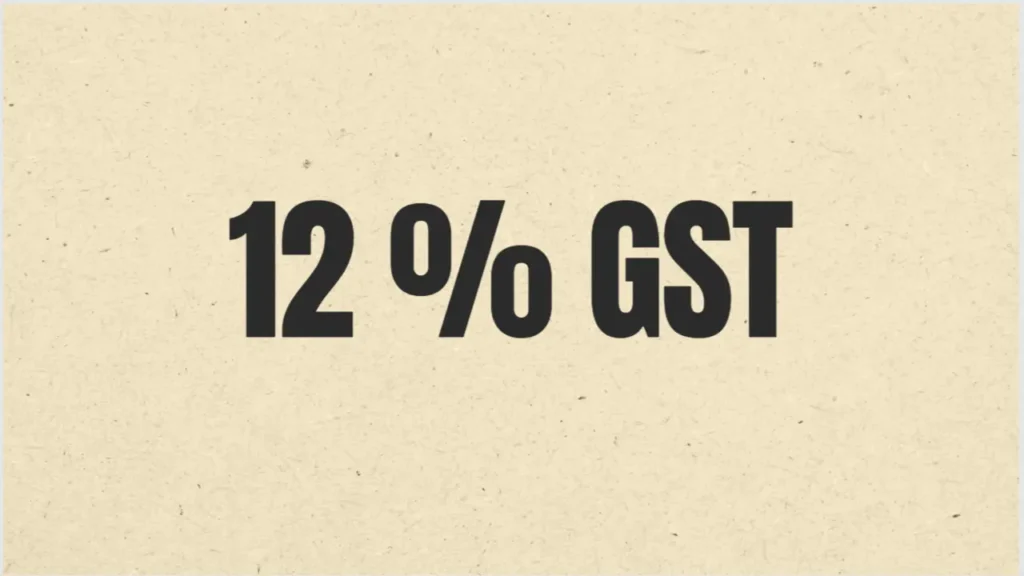Introduction
India’s Goods and Services Tax (GST), rolled out on 1 July 2017, replaced a patchwork of indirect taxes with a unified, multi-rate structure. Designed to categorize goods and services based on necessity, value addition, and affordability, GST features slabs ranging from 0% for essentials to 28% for luxury items.
Nestled in the middle, the 12% GST slab applies to products and services that are neither bare necessities nor high-end luxuries. This “mid-range” category strikes a balance—helping the government collect substantial revenue while keeping costs manageable for consumers.
What Falls Under the 12% GST Slab?
The 12% slab covers a mix of moderately priced goods and services that are widely used but not critical for survival.
Key goods in this category include:
- Processed food items – Butter, ghee, cheese, frozen meat products
- Packaged fruit juices – Except fresh fruit juice
- Basic mobile phones (pre-2020) – Later shifted to 18%, but some accessories remain at 12%
- Fertilizers – Chemical and bio-fertilizers used in agriculture
- Renewable energy equipment parts – Components for solar and wind systems
- Apparel above ₹1,000 – Mid-range clothing and accessories
Services taxed at 12% include:
- Hotel accommodation – Rooms priced between ₹1,000 and ₹7,500 per night
- Business-class rail travel – Certain premium rail services
- Work contracts – Specific infrastructure and government projects
Why the 12% Slab Exists
The GST Council’s rationale for placing goods and services in the 12% category rests on four key factors:
- Affordability for Middle-Income Consumers – Keeps prices reasonable without full tax exemption.
- Sector Support – Aids industries like agriculture and renewable energy with lower tax rates.
- Revenue Collection – Captures a significant share of GST from non-essential yet widely consumed goods.
- Market Segmentation – Creates a clear distinction between budget (5%) and premium (18%) categories.
Impact on Consumers
For buyers, the 12% GST slab means:
- Affordable mid-range hotel stays
- Cheaper access to fertilizers for farmers
- Mid-priced fashion that remains within reach
However, in highly price-sensitive markets, even a 12% rate can influence consumer choices—especially when similar products are available in the 5% category.
Impact on Businesses
Advantages:
- Lower consumer resistance compared to the 18% slab
- Input Tax Credit (ITC) benefits help reduce overall tax burdens
- Competitive positioning for mid-range products
Challenges:
- Pricing thresholds, such as ₹7,500 for hotel rooms, can force businesses to adjust rates strategically
- Disputes over product classification to secure lower tax rates
Recent Changes & GST Council Decisions
The 12% slab has seen several policy shifts in recent years:
- March 2020 – GST on mobile phones increased from 12% to 18% to fix inverted duty structures.
- 2019 – GST on mid-range hotel rooms reduced from 18% to 12% to encourage tourism.
- Renewable energy – Certain solar and wind components remain at 12% to promote green initiatives.
In the 55th GST Council Meeting (December 2024), discussions included scrapping the 12% slab entirely—moving items to either 5% or 18% for a simpler tax structure.
Challenges Ahead
- Rate Rationalization Risks – Merging slabs could push products into higher tax brackets, raising consumer costs.
- Inverted Duty Structure – Higher taxes on inputs than outputs lead to refund delays.
- Market Distortions – Price thresholds sometimes drive artificial pricing strategies.
The Road Ahead
The future of the 12% GST slab remains uncertain:
- Government Direction – Moves toward a simpler GST system with fewer slabs could make the 12% rate redundant.
- Industry Concerns – Businesses want stability to avoid sudden cost spikes.
- Green Priorities – Eco-friendly goods may remain at 12% to balance affordability and promotion.
Conclusion
The 12% GST slab has long been the “middle ground” of India’s tax system—offering affordability to consumers while ensuring healthy revenue for the exchequer. It has been especially beneficial for sectors like hospitality, agriculture, and renewable energy.
But with tax reform debates heating up, this mid-tier category could soon vanish. Whether merged into other slabs or preserved for specific industries, the 12% GST rate will continue to influence pricing strategies, consumer behavior, and government policy for years to come.
